- Details
- Hits: 2532
According to NewAtlas.com (https://newatlas.com/architecture/sun-tower-open/), construction of the Sun Tower exhibition building and outdoor theater is underway in the Chinese city of Yantai. The tower is being constructed by a French firm, Ducks Sceno and the engineering firm Arup, raising to 50m (164 ft) gracefully into the sky. The tower symbolizes the historic watch towers of the Ming dynasty (1368 to 1644 CE). Yantai literally means "Beacon Tower", named for the watch towers that look out over the coastline to warn of impending attack from the sea.

Adam Williams, author the the Sun Tower article of 16 Feb 2022 notes: "The concave form of the building will amplify sounds from the sea... Additionally, its shape has been created following careful studies of the sunlight during the times of the equinox in both the spring and fall. The main body of the tower will work with a plaza surrounding the building to track each equinox, a little like the Shanghai Astronomy Museum, by Ennead Architects. A water channel will cut across the plaza – a ruler of time – this is the straight line that the shadow of the Sun Tower will follow on the day of the equinox. A series of elliptical rings are set in the pavement pattern [with] the intersections between the rings and the water channel marking the building shadow's footprint at specific hours on the equinox day. At one of the outer rings, a series of fountains were designed to celebrate the 24 Solar Terms of the Traditional Chinese Calendar; on normal days they are synced with high and low tides."
- Details
- Hits: 3903
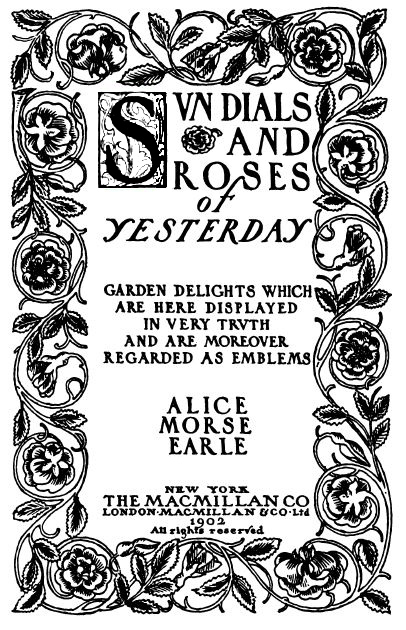 Sundials have always been part of gardens, as witnessed by Alice Morse Earle's book Sun Dials and Roses of Yesterday written 120 years ago. Her book title expanded on the cover with the subtitile "Garden Delights Which are Here Displayed in Very Truth and are Moreover Regarded as Emblems."
Sundials have always been part of gardens, as witnessed by Alice Morse Earle's book Sun Dials and Roses of Yesterday written 120 years ago. Her book title expanded on the cover with the subtitile "Garden Delights Which are Here Displayed in Very Truth and are Moreover Regarded as Emblems."
Thomas Christopher, a volunteer at the Berkshire Botanical Garden is author of a number of books on gardening and creates the Growing Greener podcast (thomaschristophergardens.com/podcast).
In a recent article for the Berkshire Eagle Thomas focused upon gardens and sunlight: Don't know where to put those light-sensitive plants? A sundial can help you figure out the light in your garden. https://www.berkshireeagle.com/arts_and_culture/home-garden/thomas-christopher-better-gardener-sundials/article_2822f5be-1d37-11ec-b39f-0fa8576b3736.html
Christopher said, "There’s a lot of focus these days on solar energy, on harnessing the light from our nearest star to fuel our daily activities. Plants, of course, have been doing just that for millions of years. Sunlight, transformed by the green stuff in their leaves, is the energy that underlies almost all plant growth. Yet, though it is so fundamental to the garden, sunlight is very poorly understood by most gardeners."His interest in sunlight deepended when he met Robert Adzema, a sculptor, artist, and most important, a sundialist for onearly 50 years. Robert is a long time member of the North American Sundial Society and in 2004 Robert and Hal Brandmaier hosted the NASS annual conferance in Tenafly, NJ.
Christopher continued, "Robert is a sculptor who originally became interested in the varying nature of sunlight and its natural cycles because of the impact they have on the appearance of outdoor art. Robert soon moved from speculation to the study of a branch of sculpture that had, over millennia, subjected sunlight to a rigorous analysis. That is, sundials."
"With the encouragement of Robert’s sundials ... I’ve come to appreciate how the apparent motion of the sun across the vault of the sky changes with the seasons. I say “apparent” because of course it is we and the earth that actually move relative to the sun; the sun doesn’t cross the sky, it is just that the rotation of the earth makes it appear to do so. In the winter, the sun appears to ride low in the sky, rising through the spring to summer heights, and then sets again in the fall..."
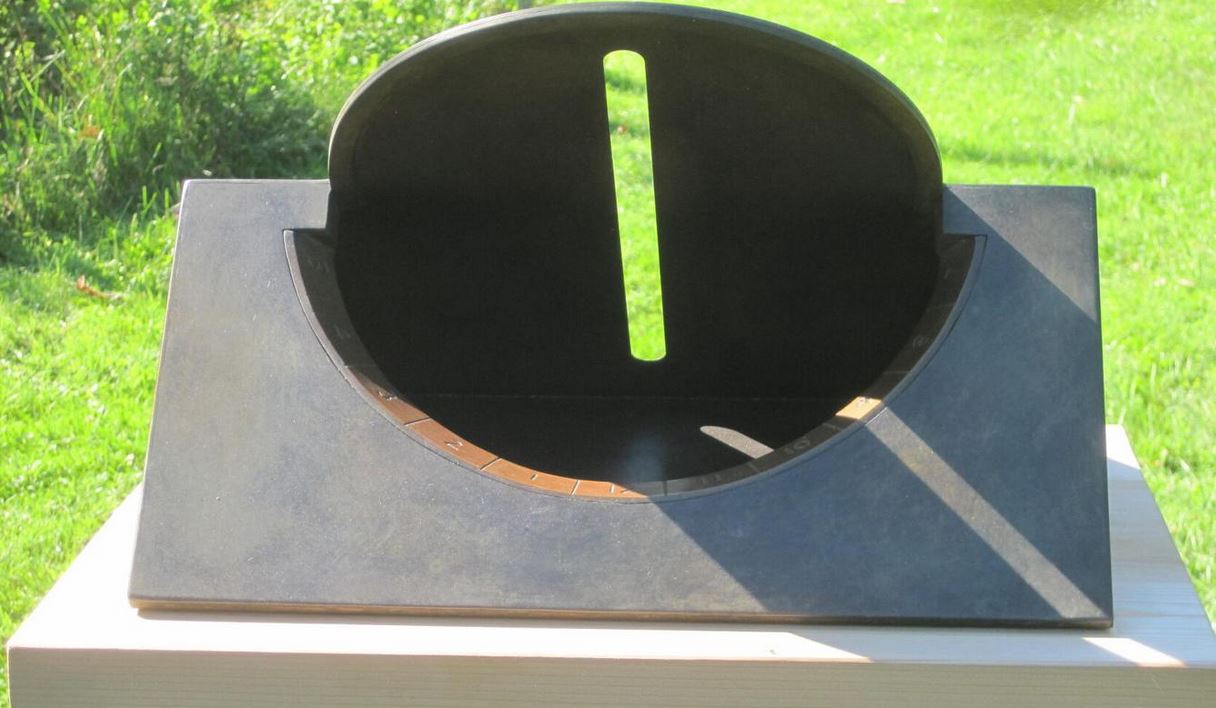 "Learning about the changes in the position of the sun relative to the earth has informed my gardening. Instructions for the placement of some light-sensitive plants, for example, recommend setting them where they will receive some early afternoon shade, shelter at the hottest part of the day. I know how to predict such a spot now, rather than merely rely on trial and error. And I know how to locate a spot for spring bulb plantings that will be penetrated by the sun early in the growing season when those plants need the solar fuel, even though it may be shaded later when the summer sun stands higher in the sky," and the bulbs are dormant.
"Learning about the changes in the position of the sun relative to the earth has informed my gardening. Instructions for the placement of some light-sensitive plants, for example, recommend setting them where they will receive some early afternoon shade, shelter at the hottest part of the day. I know how to predict such a spot now, rather than merely rely on trial and error. And I know how to locate a spot for spring bulb plantings that will be penetrated by the sun early in the growing season when those plants need the solar fuel, even though it may be shaded later when the summer sun stands higher in the sky," and the bulbs are dormant.
"The greatest benefit of a sundial in the garden, according to Robert, is the connection it creates between the viewer and the place. Reading a sundial unites the reader with the placement of the garden on the earth and with the season as well as the time of day and the heavens. Sundials, we agreed, take their time, in every sense of the phrase."
- Details
- Hits: 8087
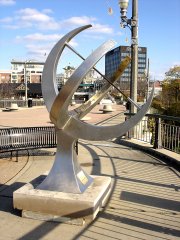 In October 1999 the cities of Lafayette and West Lafayette, IN dedicated a modern looking 8-foot high equatorial dial in honor of the coming millennium. The dial was designed and built by David Aho with a stainless steel equatorial band 60 inches in diameter. The equatorial band has a brass inlay showing the hour marks with Roman numerals. The dial still looking clean and modern located on the John T. Myers Pedestrian Bridge and has a dedication plaque Oct 22,1999. As reported by wlfi.com news, it was one of the first public art installations in the community. Now the dial is celebrated as paart of October's Community Planning Month. You can see photos of the dial on the NASS registry at http://www.sundials.org/index.php/sundial-registry/onedial/376.html or you can watch the Wlfi.com video at: https://www.wlfi.com/content/news/October-is-now-known-as-Community-Planning-Month-in-Greater-Lafayette-562876071.html
In October 1999 the cities of Lafayette and West Lafayette, IN dedicated a modern looking 8-foot high equatorial dial in honor of the coming millennium. The dial was designed and built by David Aho with a stainless steel equatorial band 60 inches in diameter. The equatorial band has a brass inlay showing the hour marks with Roman numerals. The dial still looking clean and modern located on the John T. Myers Pedestrian Bridge and has a dedication plaque Oct 22,1999. As reported by wlfi.com news, it was one of the first public art installations in the community. Now the dial is celebrated as paart of October's Community Planning Month. You can see photos of the dial on the NASS registry at http://www.sundials.org/index.php/sundial-registry/onedial/376.html or you can watch the Wlfi.com video at: https://www.wlfi.com/content/news/October-is-now-known-as-Community-Planning-Month-in-Greater-Lafayette-562876071.html
- Details
- Hits: 7339
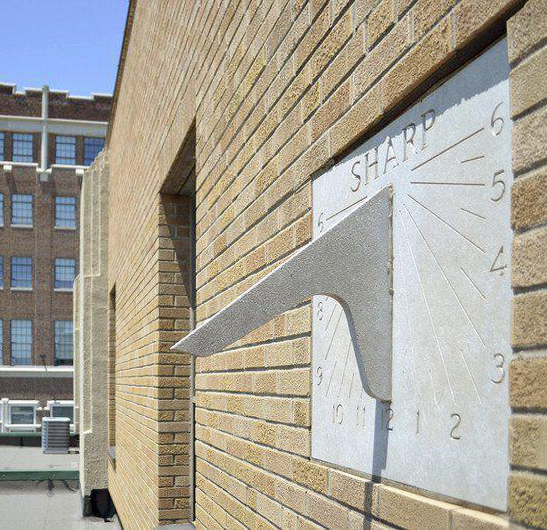 In downtown Joplin, MO, John Hadsall of the Globe digital edition began probing into the sundial on the face of Ron Jones's Commerce Building at 113 West 3rd St. Hadsall says, "I’ve been enchanted with this sundial ever since I noticed it during a lunch-break walk. I’ve written before about how I hoof it downtown and find all sorts of treasures under our noses, from the amazing front porches in the North Heights Neighborhood to the brick sidewalks that remain throughout that neighborhood, Murphysburg and other downtown residential areas."
In downtown Joplin, MO, John Hadsall of the Globe digital edition began probing into the sundial on the face of Ron Jones's Commerce Building at 113 West 3rd St. Hadsall says, "I’ve been enchanted with this sundial ever since I noticed it during a lunch-break walk. I’ve written before about how I hoof it downtown and find all sorts of treasures under our noses, from the amazing front porches in the North Heights Neighborhood to the brick sidewalks that remain throughout that neighborhood, Murphysburg and other downtown residential areas."
"The sundial is believed to have always been a part of the more than 100-year-old-building. Originally built in 1904 for a machinery company, it was remodeled into a bus station in 1937." And over the years the building was abandon, finally being purchased by Jones and his business partner Ivan McElwee. John proceeded to see if the dial told accurate time, taking a photo of the dial and its shadow "at about 1:05 pm on Thursday [18 July 2019], I took a picture of the sundial at 111 W. Third St... It appeared to be a little behind: The shadow of the gnomon was still crawling toward dead center of the 12."
- Details
- Hits: 12393
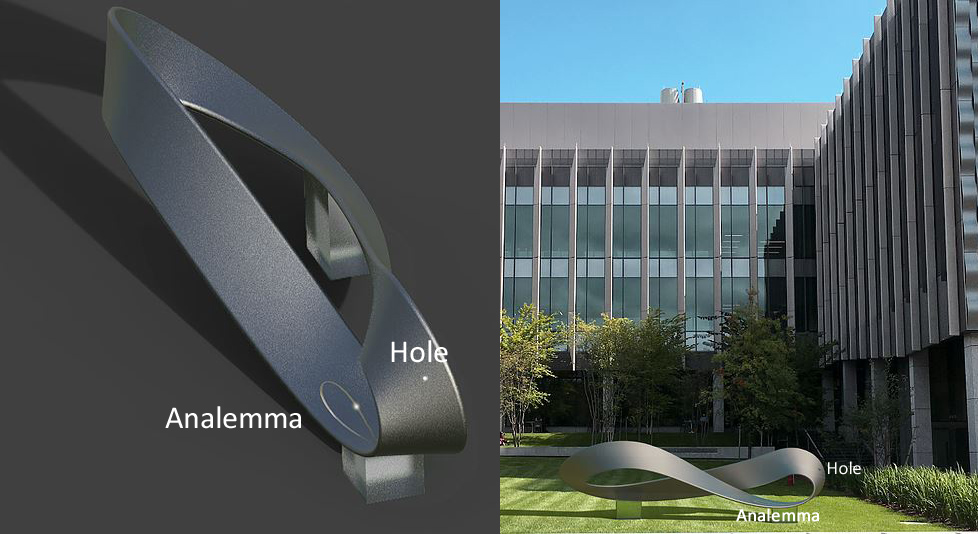 "Infinity Possibility" was dedicated this week [May 5th, 2019] at Brown University in Providence R.I. thanks to a grand design challenge to the university's School of Engineering by 1979 alum Charlie Giancarlo. Giancarlo wanted something "that would represent the rigor of engineering work, but have artistic beauty as well". According to Brown news, "A student group called Brown STEAM (Science Technology Engineering Arts and Mathematics) took up the challengte, and the result of more than two years work is a stainless steel noon mark sundial measuring 15 feet long and 4 feet high. STEAM’s then-president tapped Austin and David Schurman, both first year students at the time, as project managers. The pair assembled a team of around 20 students to start brainstorming ideas and getting input from the broader Brown community.
"Infinity Possibility" was dedicated this week [May 5th, 2019] at Brown University in Providence R.I. thanks to a grand design challenge to the university's School of Engineering by 1979 alum Charlie Giancarlo. Giancarlo wanted something "that would represent the rigor of engineering work, but have artistic beauty as well". According to Brown news, "A student group called Brown STEAM (Science Technology Engineering Arts and Mathematics) took up the challengte, and the result of more than two years work is a stainless steel noon mark sundial measuring 15 feet long and 4 feet high. STEAM’s then-president tapped Austin and David Schurman, both first year students at the time, as project managers. The pair assembled a team of around 20 students to start brainstorming ideas and getting input from the broader Brown community.
David Shurman and his team worked with a sundial expert, Bill Gottesman, a member of the North American Sundial Socity, Shurman said, "We wanted to explore the interplay of the mobius strip's shape with that of Brown's unique analemma path to make a sculpture personalized to the location it will inhabit for, hopefully, up to a century." In the end section of the "lazy eight" mobius strip is a hole allowing the noonday sun to fall on the northward piece of the strip below. The lower mobius band has an etched analemma showing civil noon in front of Brown's Engineering Research Center.
Read more: https://www.brown.edu/news/2019-05-08/sundial and https://www.davidschurman.com/copy-of-project-page-template
- Details
- Hits: 7594
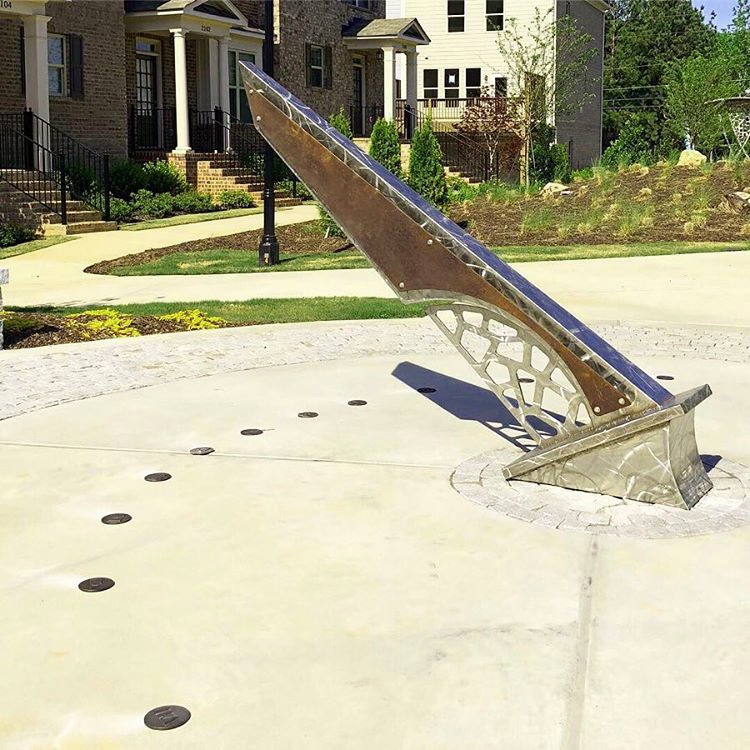 On May 3, 2019 new sundial graces the City of Kennesaw, Georgia just a short way from Atlanta. The Marietta Daily Journal reported the unveiling of the sundial, a large gateway sign, and a shade structure at the new townhouse site. Developers of Kennesaw Gateway Park, a new group of townhouses within walking distance of of town center, collaborated with Kennesaw State University (KSU) to design and fabricate a 9-foot tall horizontal sundial that has been placed in the circular plaza of the housing common area. Page Burch, a lecturer of KSU's Master Craftsman Program was the lead coordinator to design and fabricate the sundial gnomon. The stainless steel gnomon has a brass verneer and an unusual tilted based that nevertheless results in the the gnomon angle of 34 degrees exactly correct for the site latitude.
On May 3, 2019 new sundial graces the City of Kennesaw, Georgia just a short way from Atlanta. The Marietta Daily Journal reported the unveiling of the sundial, a large gateway sign, and a shade structure at the new townhouse site. Developers of Kennesaw Gateway Park, a new group of townhouses within walking distance of of town center, collaborated with Kennesaw State University (KSU) to design and fabricate a 9-foot tall horizontal sundial that has been placed in the circular plaza of the housing common area. Page Burch, a lecturer of KSU's Master Craftsman Program was the lead coordinator to design and fabricate the sundial gnomon. The stainless steel gnomon has a brass verneer and an unusual tilted based that nevertheless results in the the gnomon angle of 34 degrees exactly correct for the site latitude.
Credit is also given to the KSU College of Science and Mathematics for calculating the gnomon angles and hour lines for positioning the hour-mark disks. These disks are embedded in a circular arc in the concrete. The 6am-6pm disks line up behind the gnomon mount, but again are correct when the style edge is followed to th concrete floor, precisely intersecting the 6am-6pm line. No noon-mark separation was used to account for the approximate 6-inch width of the gnomon.
- Details
- Hits: 8035
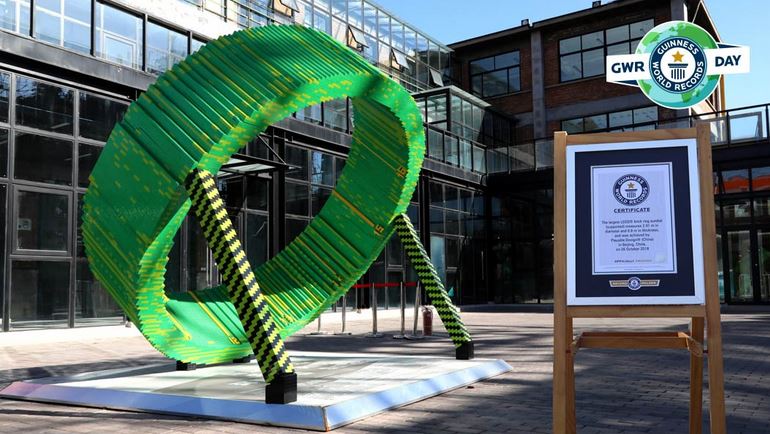 Back in March of 2012, NASS had an article about an inventive sundialist constructing a 62-LEGO block equatorial dial. That now seems like ancient history. In Beijing China, dialists have built a ring dial 9 1/2 feet in diameter consisting of more than 45,000 LEGO blocks, setting a new Guinness World Record.
Back in March of 2012, NASS had an article about an inventive sundialist constructing a 62-LEGO block equatorial dial. That now seems like ancient history. In Beijing China, dialists have built a ring dial 9 1/2 feet in diameter consisting of more than 45,000 LEGO blocks, setting a new Guinness World Record.
The dial was the idea of Mrs. Hou at Playable Design, a company that creates and develops eduational activities using LEGO construction blocks. Astronomical professionals and structural engineers were enlisted to guide this three month construction project. According to an article from the on-line Guiness World Records website, Mrs. Hou (founder of Playable Design), says the giant ring sundial "... is a teaching tool that allows children to learn sciences across disciplines including astronomy, mathematics, history and cosmology. Inspire children to think and ask questions, when they see the ring sundial, but we are all very excited to ber recognized by the Guinness World Records at the same time.... This is an important part of a public education project. For creators and educators like us, the process of learning never stops."
Watch the time-lapse video of the dial's construction:
<mp4>LEGO_sundial_construction_2018</mp4>
- Details
- Hits: 7008
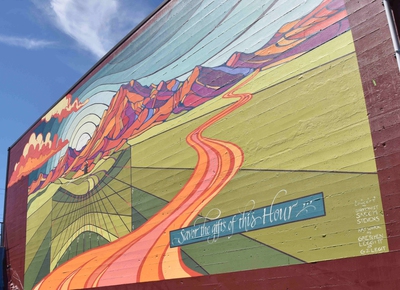 The Sundial Mural Project has been completed. Sasch Stephens of NW Sunworks spent years putting this project together and in association with Allied Arts sponsored an international competition that ultimately commissioned Gretchen Leggitt to paint a beautiful 30' x 60' wall mural incorporating the dial. The bright and engaging sundial mural is located on the south facing wall of 207 Unity Street in Bellingham, WA.
The Sundial Mural Project has been completed. Sasch Stephens of NW Sunworks spent years putting this project together and in association with Allied Arts sponsored an international competition that ultimately commissioned Gretchen Leggitt to paint a beautiful 30' x 60' wall mural incorporating the dial. The bright and engaging sundial mural is located on the south facing wall of 207 Unity Street in Bellingham, WA.
The dial and mural will be dedicated at noon Saturday, September 22, 2018 which coinsides with the date of the fall equinox. Called the "First Shadow Celebration" city council officials and noted sudialists will be present, as will Mataio Gills, co-owner of Ciao Thyme, the building that supports the mural and vertical dial. There will be music, entertainment, information about sundials, sundial kits, and a celebration of Solar Noon on the Equinox as seen on this major vertical sundial.
If you are in the Seattle-Bellingham-Vancouver area, head for the sundial dedication and First Shadow Celebration on the equinox, Saturday, Sept 22.
- Details
- Hits: 7599
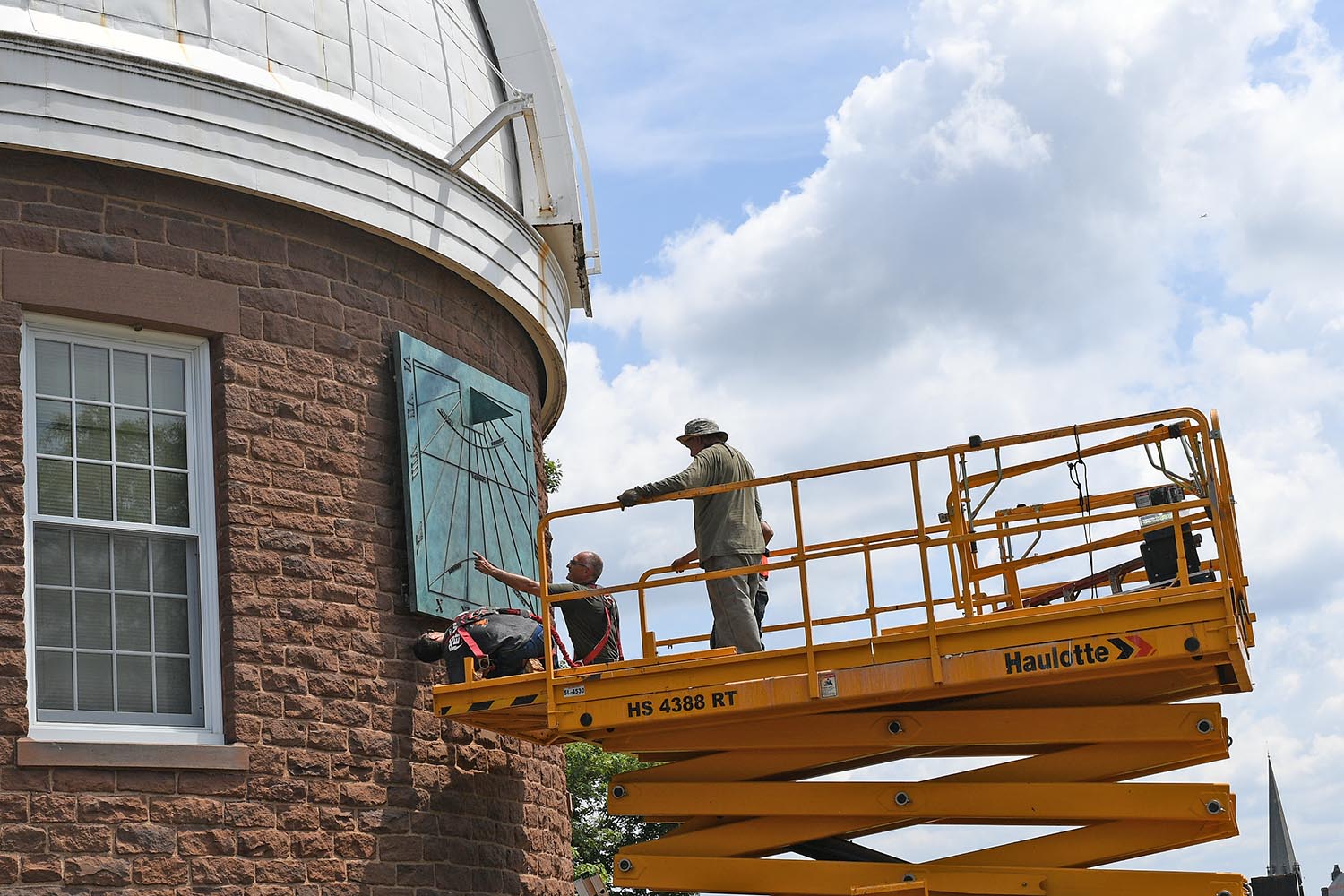 The Van Vleck Observatory has received a new sundial. In the Wesleyan news letter article by Olivia Drake who interviewed provost Joyce Jacobsen who said, "Campus doesn’t have enough outside art. A sundial is a perfect piece because it’s not only aesthetically pleasing but it’s functional too.” (https://newsletter.blogs.wesleyan.edu/2018/07/17/sundial-sculpture-installed-on-van-vleck-observatory/)
The Van Vleck Observatory has received a new sundial. In the Wesleyan news letter article by Olivia Drake who interviewed provost Joyce Jacobsen who said, "Campus doesn’t have enough outside art. A sundial is a perfect piece because it’s not only aesthetically pleasing but it’s functional too.” (https://newsletter.blogs.wesleyan.edu/2018/07/17/sundial-sculpture-installed-on-van-vleck-observatory/)
The 6 x 6 foot Muntz metal bronze sundial with stainless steel reinforcing weighing 650 pounds was carefully installed on the southern face of the 20-inch Clark Refractor dome on Foss Hill, Middletown, CT. The Alvan Clark telescope now open for public viewing was installed in July, 1922. In 1971 the Van Vleck observatory acquired the 24-inch Perkin reflector, housed in a separate dome near the west end of the old observatory building. (http://www.wesleyan.edu/astro/van-vleck/history.html)
The July 16th, almost exactly 96 years since the installation of the Clark telescope, the dome was graced by a sundial. Installation was supervised by the designer and creator, Robert Adzema (standing on the platform). He visited the campus multiple times with paper and wooden models seeking the right esthetic design. The final dial design is a true south declining sundial (notice the equinox line is parallel to the ground) but the hour lines are corrected for the longitude 72° 39.5585' W such that mean noon occurs 9m 22s after local mean noon. Hence a slight counter-clockwise twist to the hour lines (the 6am hour line is slightly below the horizontal). The shadow of the gnomon's tip traces the solstices and equinox. "I wanted the design to look timeless and in keeping with the classical nature of the building,” said Adzema. In Drake's article Adzema further commented on the patina of the bronze dial, saying, "I chose this green because it is the natural color bronze would oxidize over time. It is also a shade that looks great against the color of the observatory’s brownstone walls...The biggest difficulty was achieving the patina, which had to be applied by heating the surface of the dial and applying various chemicals and acids.”https://newsletter.blogs.wesleyan.edu/2018/07/17/sundial-sculpture-installed-on-van-vleck-observatory/
